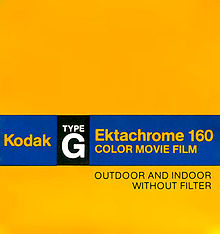Kodak EPP
Kodak EPP ( Ektachrome 100 Plus) is an older generation slide film (daylight color reversal film) with an average light sensitivity of 100 ASA . It is intended for development in the widely used E6 process. The slide film was added to the EPR 64 and EPN 100 films by Kodak in the 1980s in order to be able to offer a film with increased color saturation . Compared to the latest generation of slide films, however, the EPP has a comparatively low color saturation and is therefore ideally suited for taking pictures of people.
After the Kodachrome film family was finally phased out in 2009, the EPP was the only commercially available slide film with the classic Kodak color matching and moderate color saturation. Like the Kodachrome 64 , the Ektachrome 100 Plus has a flattering skin tone rendering. It does not achieve the sharpness and contrast of the Kodachrome 64 as a 35mm film , but surpasses it in the correct reproduction of yellow, orange and red dyes. Green tones are displayed colder than the Kodachrome 64.
The film was primarily used in the professional sector, for example as a base material for printing; Color matching and gradation (contrast) were matched to this. The slides were also suitable as templates for analog direct prints on reversal paper (e.g. Cibachrome / Ilfochrome)

